- Bernard Preston homepage
- Bread
- Terminology Used in a Grain of Wheat
Terminology used in a grain of wheat
Terminology used in a grain of wheat can be very confusing; where for example is the calcium found and what are the benefits of the bran? Why on earth do millers extract all the best parts and sell them for pig food?
Adding to the confusion is the fact that millers can legally label their meal as "whole grain" provided they do not extract more than 40% of the goodies; the germ and bran.
Caryopsis
A grain of wheat is known as the caryopsis.
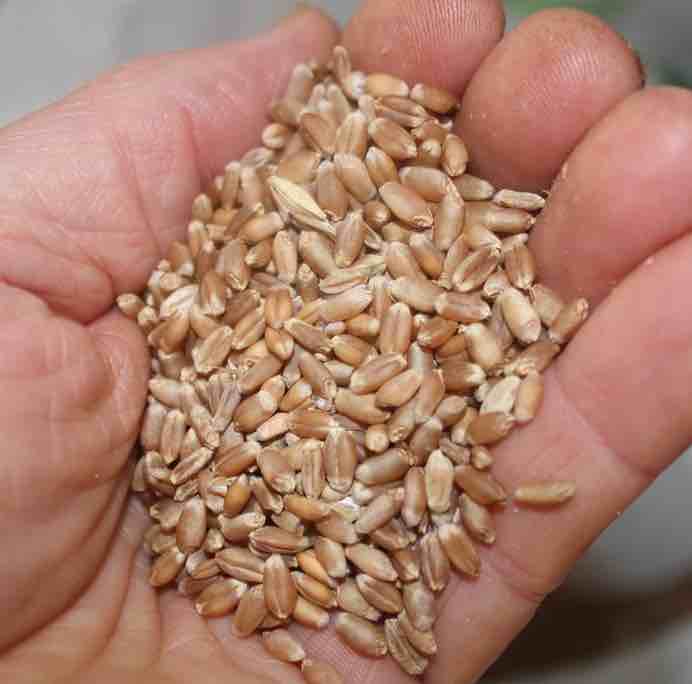
It is made up of three parts.
1. Bran
The outer branny husk makes up about 15% of the whole grain. It protects the inner parts from the elements, in particular oxygen which would cause the fats to go rancid.
The bran is made up of four layers; each contains important nutrients and fibre.
- Pericarp
- Testa
- Hyaline
- Aleurone layer
The bran is a rich source of fibre, largely of the insoluble kind. Only 5% of those enjoying typical grocery store food are getting sufficient; at least 30 grams per day, more for men.
There is strong evidence that fibre reduces the risk of many of the chronic degenerative diseases such as cardiovascular conditions, type-2 diabetes and malignant tumours.
The antioxidant properties of the polyphenols found in the bran have been shown to mop up the free radicals that cause malignant change in our cells and damage our DNA. However many of these are only released after fermentation by the friendly bugs in the healthy gut.
The happy tum must have not only plenty of fibre but also a healthy microbiome; literally trillions of friendly, diverse bacteria, viruses and yeast cells.
The bran also contains the lignans; phytonutrients that have been proven to show powerful properties of preventing many cancers, especially of the breast[3] and prostate gland. Just one slice of true 100% wholegrain bread daily would reduce the prevalence by nearly fifty percent.
The bran also contains another powerful antioxidant called ferulic acid; it is in a bound form that is only released once it reaches the colon where it is fermented by the microflora. It gives "site-specific" protection to the large bowel.
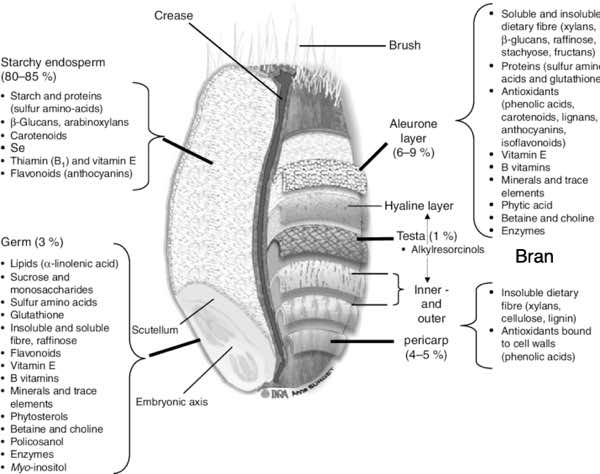
Vitamins in the bran
The bran also contains many important nutrients of the B complex such as thiamine, pyridoxine and folate; and about 25% of the vitamin E.
Pyridoxine is an incredibly important vitamin; B6. It plays an important role in over 100 enzymatic reactions, many to do with the management of glucose in the cells. It is no coincidence that it comes embedded in a starch. White flour has none; it has all been extracted. It's comes as no surprise that commercial bread, cakes and cookies have such a negative effect on diabetics.
Minerals in the bran
It is also stores many of the minerals found in wheat; calcium, magnesium and potassium for example.
Protein in the bran
The bran contains most of two important amino acids found in wheat; methonine and cystine.
SUMMARY
- Insoluble fibre that helps prevent constipation and many associated bowel diseases.
- Nutritional benefits such as the vitamins and minerals.
- Antioxidant effects from the many phenolic and other compounds.
- Two important amino acids.
2. Germ
The germ makes up about 3% of the whole grain; it is sometimes called the embryo and has been likened to the yolk of an egg.
Wheat germ is about 30% protein; it is a natural, concentrated source of essential amino acids, fats and minerals. It also contains some of the vitamins; and tocopherols that act as anticoagulants preventing clots from forming in the heart, lungs and brain.
Wheat germ also contains phytosterols that lower cholesterol.
Wheat germ oil contains two essential lipids, linoleic acid and the omega-3 known as ALA; and much of the antioxidant vitamin E. It has been shown to reduce cholesterol in both the liver and the serum.
3% of the germ is fibre.
However once the grain has been cracked high enzymatic activity begins, inducing a rapid deterioration of the nutritional value of the germ; and sharply reducing the shelf-life.
It should not be assumed that freshly-ground wheat will keep for weeks or even months; the sooner it is consumed after milling the better. Refrigeration and freezing help to slow that enzymatic activity.
Quercetin
Quercetin is the chief antioxidant phenolic found in the germ. It is a
flavonoid that mops up the free radicals which damage cell membranes
and our DNA; protection against cancer.
To increase the shelf-life of the germ commercially it is defatted using solvent extraction or supercritical CO2. The former then has to be heated to drive off the hexane; residues remain in the product. The consumer has no inkling of which method has been used.
Bakers prefer to make their products without the germ. It decreases the stretchability of the dough; and benefits the "mouth-feel."
Dough made with refined flour is stronger and the slices more favourable to the tongue and lips; the so-called mouthfeel.
SUMMARY
- The germ is extracted when processing white flour to improve its baking properties and to increase the shelf-life.
- There is consumer resistance to whole grains; they have to be chewed.
- Prior to the refining of flour heart attacks were almost unknown; vitamin E is a natural anticoagulant.
3. Endosperm
The endosperm makes up 83% of a grain of wheat; it is milled and refined to produce white flour. It is the chief part of the kernel that is used for baking.
It contains most of the protein and carb but little of the minerals, vitamins or polyphenols; and none of the fibre.
SUMMARY
- The endosperm is what is used in the main for human food.
- Most of the important nutrients, bar the protein have been extracted.
Colorectal cancer
The rate of colorectal cancer in those under the age of 55 has doubled in the last 25 years; daily red meat consumption, low fiber carbs and artificial sweeteners have all been fingered.
"Starches with a higher Carbohydrate Quality Index are associated with a 73% lower risk of dying from rectum cancer. Specifically mentioned are those foods high in dietary fiber with a low GI; and restricted alcohol and sugar-sweetened beverages."
- BMC Medicine[10]
Added bran and germ
Attempts are being made to incorporate the bran and germ into processed foods because of their nutritional content and the physiological effect on the gut. However the public at large have become so accustomed to refined grains, the mouth-feel and not needing to chew bread that these products are perceived as inferior.
That would appear to take precedence over other "organoleptic" qualities; taste, colour and odour. Despite commercial bread having no flavour of its own, it is still chosen over artisanal loaves because of its mouth-feel.
The big fat lie
There is a big fat lie in the terminology used in a grain of wheat.
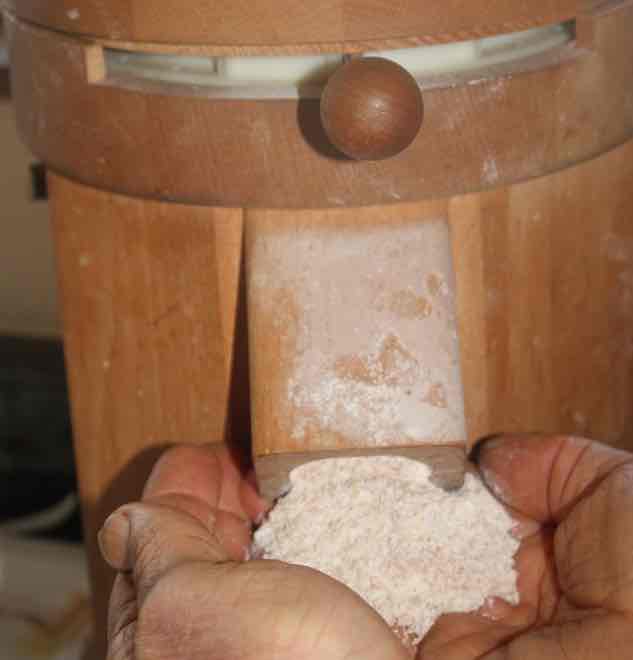
Clearly the two bread flours shown below are not the same; yet the one on the right can still be legally labelled as "wholemeal."
That on the left is milled such that the three streams are not separated. The endosperm, germ and bran are found in the exact same ratios as in the whole grain.
Extraction rate
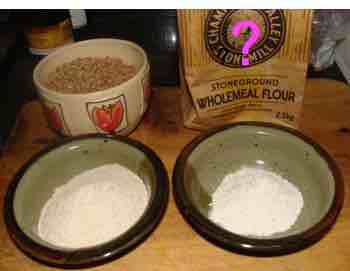 100% extraction on the left, unknown on the right.
100% extraction on the left, unknown on the right.The "extraction rate" of the flour on the left is 100%; all the fractions of the grain are present.
The extraction rate of the commercial flour on the right is unknown; it is not declared. It is certainly not 100%; some of the bran and probably the germ too have been removed.
It is probably around that of brown flour; about 80 to 90%. Up to 20 percent of the total weight has been extracted; most of the bran and some of the germ. You just do not know. It is not declared; the big fat lie. It is certainly not the "wholemeal flour" declared on the label.
Calcium
To atone for the extraction of most of the minerals in the ultra-refining of flour many countries make it mandatory for millers to add synthetic forms. However there is great concern in cardiovascular circles since that raises coronary calcium; it is deposited in the intima of capillaries making them stiff and raising blood pressure.
Gluten
Gluten is the protein in flour. Roughly one in a hundred people may be allergic to it.
Historically for millennia bread has been baked by the sourdough method. The gluten is predigested even before being put in the oven. But the Chorleywood process, the refining of wheat and the addition of various chemicals have completely altered the staff of life from the much desired food enjoyed by our ancestors. It has little taste, is extremely fattening and gives no protection against serious disease.
Misconceptions
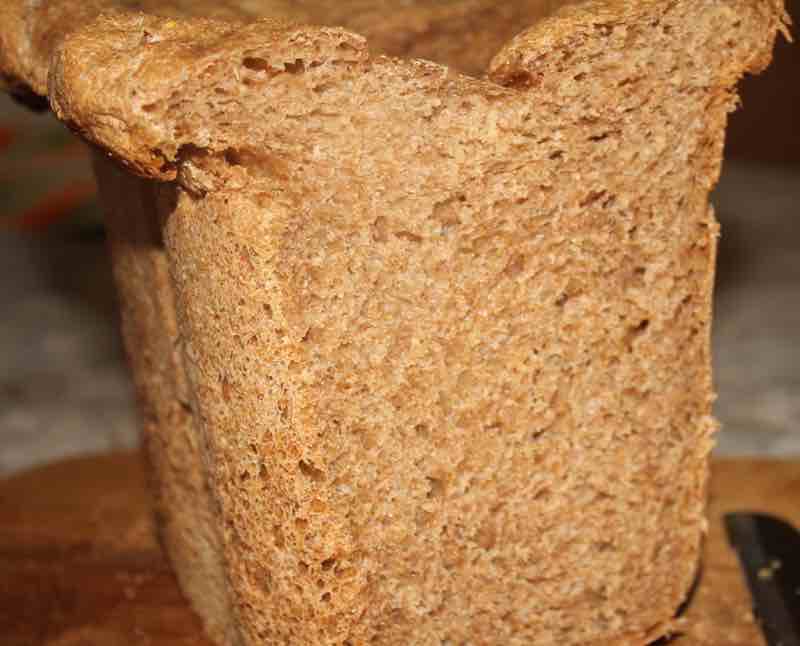 A long ferment sourdough bread is surprisingly light
A long ferment sourdough bread is surprisingly lightWe are under the weight of three great misconceptions.
- Whole grain bread is heavy like a German roggebrood; nothing could be further from the truth.
- Choosing ultra refined grains that are gluten-free is a step up in health.
- Carbs are bad, period; and should be strenuously avoided.
Terminology used in a grain of wheat
The terminology used in a grain of wheat helps us to understand the nutrition and importance of whole grains; and why white flour raises blood glucose and causes obesity.
When browsing use right click and "Open Link in New Tab" or you may get a bad gateway signal.
Newsletter
Our newsletter is entitled "create a cyan zone" at your home, preserving both yourself and Mother Earth for future generations; and the family too, of course. We promise not to spam you with daily emails promoting various products. You may get an occasional nudge to buy one of my books.
Here are the back issues.
- Lifestyle and ideal body weight
- What are ultra-processed foods?
- Investing in long-term health
- Diseases from plastic exposure
- Intensive lifestyle management for obesity has limited value
- A world largely devoid of Parkinson's Disease
- The impact of friendly bacteria in the tum on the prevention of cancer
- There's a hole in the bucket
- Everyone is talking about weight loss drugs
- Pull the sweet tooth
- If you suffer from heartburn plant a susu
- Refined maize meal and stunting
- Should agriculture and industry get priority for water and electricity?
- Nature is calling
- Mill your own flour
- Bake your own sourdough bread
- Microplastics from our water
- Alternative types of water storage
- Wear your clothes out
- Comfort foods
- Create a bee-friendly environment
- Go to bed slightly hungry
- Keep bees
- Blue zone folk are religious
- Reduce plastic waste
- Family is important
- What can go in compost?
- Grow broad beans for longevity
- Harvest and store sunshine
- Blue zone exercise
- Harvest and store your rainwater
- Create a cyan zone at your home
Did you find this page interesting? How about forwarding it to a friendly book or food junkie? Better still, a social media tick would help.
- Bernard Preston homepage
- Bread
- Terminology Used in a Grain of Wheat
Address:
56 Groenekloof Rd,
Hilton, KZN
South Africa
Website:
https://www.bernard-preston.com